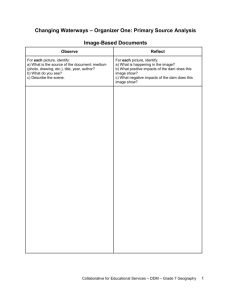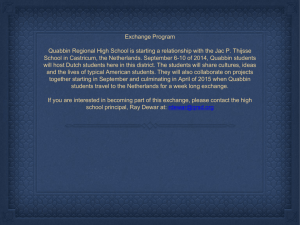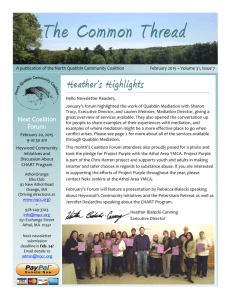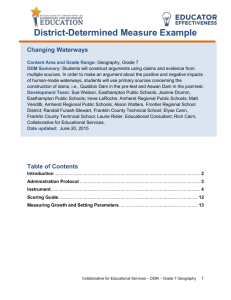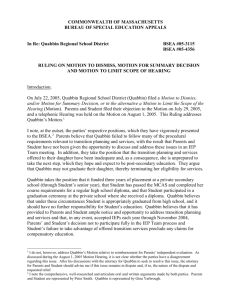Paper 2: Bibliographical Essay The Quabbin Reservoir: Pro and Con
advertisement
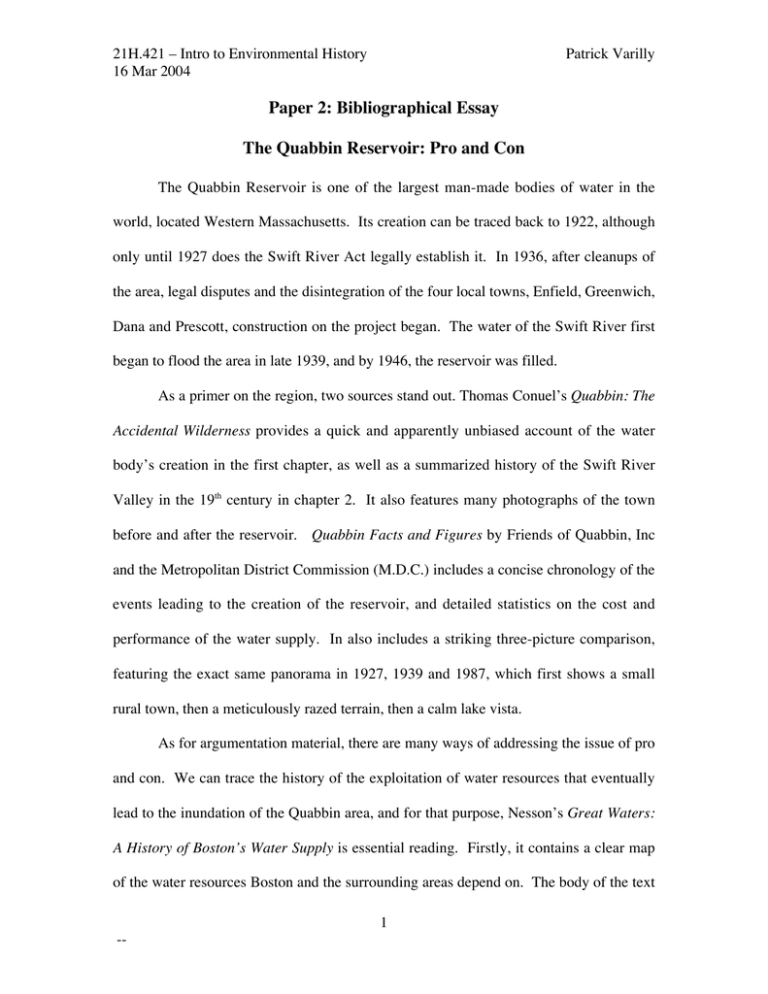
21H.421 – Intro to Environmental History 16 Mar 2004 Patrick Varilly Paper 2: Bibliographical Essay The Quabbin Reservoir: Pro and Con The Quabbin Reservoir is one of the largest man-made bodies of water in the world, located Western Massachusetts. Its creation can be traced back to 1922, although only until 1927 does the Swift River Act legally establish it. In 1936, after cleanups of the area, legal disputes and the disintegration of the four local towns, Enfield, Greenwich, Dana and Prescott, construction on the project began. The water of the Swift River first began to flood the area in late 1939, and by 1946, the reservoir was filled. As a primer on the region, two sources stand out. Thomas Conuel’s Quabbin: The Accidental Wilderness provides a quick and apparently unbiased account of the water body’s creation in the first chapter, as well as a summarized history of the Swift River Valley in the 19th century in chapter 2. It also features many photographs of the town before and after the reservoir. Quabbin Facts and Figures by Friends of Quabbin, Inc and the Metropolitan District Commission (M.D.C.) includes a concise chronology of the events leading to the creation of the reservoir, and detailed statistics on the cost and performance of the water supply. In also includes a striking three-picture comparison, featuring the exact same panorama in 1927, 1939 and 1987, which first shows a small rural town, then a meticulously razed terrain, then a calm lake vista. As for argumentation material, there are many ways of addressing the issue of pro and con. We can trace the history of the exploitation of water resources that eventually lead to the inundation of the Quabbin area, and for that purpose, Nesson’s Great Waters: A History of Boston’s Water Supply is essential reading. Firstly, it contains a clear map of the water resources Boston and the surrounding areas depend on. The body of the text 1 - 21H.421 – Intro to Environmental History 16 Mar 2004 Patrick Varilly is concerned with the westward expansion of the water supply. Of particular interest are chapters 3 (Quabbin) and 4 (Water and Social Engineering), pgs. 36-86. The first one examines the legal process by which Quabbin was chosen as a reservoir site, as proposed by Goodnough, and discusses the alternative proposals by Hazen and Freeman. Nesson’s essential thesis is that the main factor in selecting Quabbin was opposition for filtration of alternative sources. The book also has useful biographies of the main personalities behind the engineering effort. Almost uniquely, this book phrases the Quabbin issue exclusively in a political framework, and discusses it mainly from the point of view of Boston citizens, paying sporadic homage to the protests of the Quabbin towns. J. R. Greene, in The Creation of Quabbin Reservoir: The Death of the Swift River Valley, provides a similar exposition, though in more detailed and with less oversimplification. The important segment of the book is Part III: The Water Fight, pgs 25—57. In them, Greene works through the proposals that suggested the creation of the Quabbin in 1922, and the resulting political unrest. The source is essential for understanding the popular psyche at the time. It also has background information on the contemporary political arena. One recurring theme in Greene’s work is people suing the state for unjust compensation, instances of which are not hard to come by. Relevant court cases include Albert E. Beaman v. Commonwealth (unfair exclusion in indemnification, rejected), Franklin A. Snow Company vs. Commonwealth (contractor defrauded by Commonwealth, damages awarded) and The Arthur A. Johnson Corporation vs. Commonwealth (misrepresentation of facts by Commonwealth, rejected). Greene has also authored other important works on the Quabbin reservoir. His compilation, A Bibliography of Quabbin Valley History, stands as the definitive guide to 2 - 21H.421 – Intro to Environmental History 16 Mar 2004 the primary sources. Patrick Varilly Concretely, pages 19—22 list the relevant Massachusetts legislation, from the Goodnough report of January 1922, to the Ware River Act of 1926 and the Swift River Act of 1927, as well as the intervening legal debates. Pages 29—38 enumerates a wealth of technical publications on the subject, many by the original proponents of the projects; though comprehensive, these sources are hard to obtain due to their age and, sometimes, obscurity of the journals. Greene’s The Day Four Quabbin Towns Died is useful in reconstructing the emotional sensitivities of the Quabbin community around the time of the oft-mentioned Enfield ball of April 27, 1938, but is otherwise of little value when examining the pros and cons of Quabbin’s construction in a larger context. Nonetheless, Appendix I in pages 77—83 includes the full text of the disincorporation law that removed Dana, Enfield, Greenwich and Prescott from the map. His An Atlas of the Quabbin and Ware River Diversion provides a quick reference of useful facts about the local populations (including town sizes, listed every 10 years from 1810 to 1940). More importantly, though, it clearly demarcates Greene’s position on the issue: he calls the reservoir “a prime example of the policy of the state government to view Western Massachusetts as a place to exploit for the advantage of the Boston area.” It is thus evident Greene is against the creation of the reservoir. An interesting contrast to Greene’s people-centric accounts is glimpsed at by looking at a New York Times article, “Big Reservoir Dam Begun in Bay State,” 23 May, 1937. It emphasizes the engineering technicalities of the project, while barely noting the disappearance of the valley’s towns. It’s symbolic of urban views on Quabbin. 3 - 21H.421 – Intro to Environmental History 16 Mar 2004 Patrick Varilly These works are primarily concerned with contemporary views of the reservoir. Most other sources focus on its long-term effect, particularly its present important as a wilderness sanctuary. Conuel’s Quabbin: The Accidental Wilderness is chief among the sources outlining this point of view. He describes the Quabbin bald eagle conservation project, the establishment of recreational fishing (both in chapter 3), the presence of rare fauna like mountain lions and coyotes, and the forest management projects underway by the M.D.C. (chapter 4). It also has many wildlife photographs by Jack Swedberg, the head of the bald eagle project. The New York Times feature “Wood, Field and Stream” repeatedly reports on excellent fishing experiences at Quabbin, emphasizing its recreational use: “Quabbin”, by Nelson Bryant, 11 Jun 1967 and “Quabbin a Happy Hunting, Fishing Area for Massachusetts Sportsmen” by John W. Randolph, 5 Jun 1956, are representative selections. Also in the New York Times, “Symbol of Wilds’ Return Flies in Massachusetts,” by Anne Driscoll, 21 Aug 1988, reports on the bald eagle conservation project. “Reservoir Spills Over Into Recreation Field”, published 11 Jun 1967, discusses the opening up of Quabbin to hikers, travelers and fishermen; it emphasizes the beauty of the wilderness. The Worcester Telegram and Gazette ran “Quabbin Strengths, Problems Outlined” on 26 Aug 1997, a more extensive review of fishing and wildlife preservation at the reservoir. It also talks about opposition to recent proposals to expand the use of the reservoir and the filtration of other water sources. Other newspaper articles have reflections of former residents. In general, the lack of specificity makes these sources less valuable, but they give a general sense of local perceptions. “A Half Century of Nostalgia for 4 Submerged Towns” in the New York Times of 27 Dec 1987 reports on a ball to be in 1988 to commemorate the 50 years since 4 - 21H.421 – Intro to Environmental History 16 Mar 2004 Patrick Varilly the Enfield ball, and local reaction to both events. “Resident Recalls drowned villages” by Lori Stabile, in The Republican, 27 Oct 2003, and “Ex-residents recall sacrifice to Quabbin” in the Boston Herald, 16 July 2000, offer more local testimony of the events. Still other articles try to refresh the conflict spawned by Quabbin. “Recalling the towns drowned for Boston” in the Boston Globe, 29 Nov 1992, is one example. Former residents characterize Quabbin as a symbol of Boston “taking what it wants”, and the article notes the towns near Quabbin have no access to its water. Other sources offer more first-hand accounts. David Howe’s Quabbin: The Lost Valley is regularly cited as an extensive (650+ pages) compilation of local testimonies and reactions to the reservoir; however, I was unable to obtain it myself in time for this essay (it is available at the Boston Public Library, Boston College Library and Harvard, among others). The Friends of Quabbin Inc. website (www.foquabbin.org) features modern-day reflections. The archive of newsletters of the organization, published 2-4 times a year and going back to May 2001, is very useful. It exhibits resentment by many of the displaced Quabbin natives and their descendents. For example, the Oct 2003 newsletter reads “The people of the Valley did not give up their homes to provide a playground for pleasure seekers.” The editorial on Dec 2002 shows bitterness for what is long gone. J. R. Greene appears regularly in the newsletter. Overall, arguments for and against Quabbin can be divided into two categories: those dealing with its creation, and the urban-rural conflict that emerged and still lingers today, and those about its current ecological importance as a wildlife sanctuary. This essay has sketched out the sources that would be most useful in pursuing these lines of argument further. 5 - 21H.421 – Intro to Environmental History 16 Mar 2004 Patrick Varilly Annotated Bibliography [1] Bisbee, Dana, Ex-residents recall sacrifice to Quabbin, Boston Herald, 16 July 2000, p. 16. Quick overview of Quabbin facts and first-hand account of displaced residents. Describes a former Enfielder returning to the site of his house (still overwater), 70 years after he left. [2] Bryant, Nelson, Wood, Field and Stream: Quabbin, New York Times, 11 Jun 1967, pg. 215. Describes fishing opportunities in Quabbin. [3] Conuel, Thomas, Quabbin: The Accidental Wilderness, U. Mass Press, Amherst, 1981. Contains a brief historical outline of pre-Quabbin Swift River Valley towns, and the creation of the reservoir. Focuses on wildlife enhancement and preservation projects (bald eagle, mountain lion, coyote), as well as touristical development of the area (hiking, fishing). Also contains arguments about future expansion of Quabbin and creation of other reservoirs. Includes photographs of the area before and after the reservoir was built, and photos of wildlife. [4] Driscoll, Anne, Symbol of Wilds’ Return Flies in Massachusetts, New York Times, 21 Aug 1988, p.43. Reports on the bald eagle conservation project. A former resident is quoted as deriving satisfaction from this. [5] Friends of Quabbin Inc. website (www.foquabbin.org), accessed 14 Mar 2004. Includes short historical notes and, most importantly, archive of newsletters of the organization, published 2-4 times a year and going back to May 2001. [6] Friends of Quabbin, Inc and the Metropolitan District Commission, Division of Watershed Management, Quabbin Section, Quabbin Facts and Figures, Hamilton I. Newell, Inc., Amherst, 1996. Includes chronology of the events in the area, 6 - 21H.421 – Intro to Environmental History 16 Mar 2004 Patrick Varilly detailed statistics on cost and performance of reservoir and engineering measurements. Includes a three-picture comparison of one selected area before (1927), during (1939) and after (1987) the reservoir’s construction (this picture series is reproduced elsewhere, including the Friends of Quabbin, Inc. website). [7] Gaines, Judith, Recalling the towns drowned for Boston, Boston Globe, 29 Nov 1992, p.73. Mentions benefits of beauty and wildlife, but emphasizes bitterness of former residents. Resident quoted as characterizing Quabbin as a symbol of Boston “taking what it wants”. Notes none of the neighbouring Quabbin towns can access water. Brief description of 4 submerged towns. [8] Greene, J. R., An Atlas of the Quabbin and Ware River Diversion, J & P Printing Co., Athol, 1996. Contains an introduction to the valley’s history, plus a quick survey of the events 1920-1940. Features single-page overviews of each town destroyed, maps and population statistics (listed every 10 years, 1810-1940). [9] Greene, J. R., A Bibliography of Quabbin Valley History, Transcript Press, Athol, 1992. Comprehensive guide to primary and secondary sources on Quabbin, of varying utility. Pages 19—22 list the relevant Massachusetts legislation. Pages 29—38 technical publications on the subject, many by the original proponents of the projects. [10] Greene, J. R., The Creation of Quabbin Reservoir: The Death of the Swift River Valley, Performance Press, Athol, 1981. Provides a chronological account of water resource exploitation of Boston, leading up to creating of Quabbin, and discusses its effects. Part III: The Water Fight, pgs 25—57, is very useful. Describes political background to the Quabbin legislation and wades through 7 - 21H.421 – Intro to Environmental History 16 Mar 2004 Patrick Varilly many of the legal debates (in particular, contains details on indemnification suits, as opposed to Nesson). Contains biographies of political personalities and maps of the area. [11] Greene, J. R., The Day Four Quabbin Towns Died, Transcript Press, Athol, 1985. Describes setting on the days prior and following the Enfield ball of April 27, 1938 (last social event before the disincorporation of towns). Includes wealth of details on contemporary events, town meetings and population rosters. Appendix I in pages 77—83 includes the full text of the disincorporation law. [12] Miner, Bradford L., Quabbin Strengths, Problems Outlined, Worcester Telegram and Gazette, 26 Aug 1997, p. B6. Reviews fishing and wildlife preservation at the reservoir. Mentions tourism as a benefit to the area. Talks about opposition to filtration as a means to expand water resources. [13] Nesson, Fern N., Great Waters: A History of Boston’s Water Supply, University Press of New England, Hanover & London, 1983. Features a clear map of the water resources feeding the Greater Boston Area. The body of the text is concerned with the westward expansion of the water supply. Relevant sections include chapter 3 (Quabbin) and 4 (Water and Social Engineering), pgs. 36-86. Discusses legal debates surrounding creation of Quabbin: more succinct than Greene, but focuses mostly of Boston side and engineering aspects. Also discusses suit by Connecticut on Massachusetts for impounding a tributary to the Connecticut River. Importantly, Chapter 4 argues why Quabbin was established. 8 - 21H.421 – Intro to Environmental History 16 Mar 2004 [14] Patrick Varilly Randolph, John W., Wood, Field and Stream: Quabbin a Happy Hunting, Fishing Area for Massachusetts Sportsmen, New York Times, 5 Jun 1956, p.42. Details Quabbin fishing opportunities. [15] Stabile, Lori, Resident Recalls drowned villages, The Republican, 27 Oct 2003, p. B01. Eyewitness testimony, 70 years after the fact. [16] Staff, A Half Century of Nostalgia for 4 Submerged Towns, New York Times, 27 Dec 1987, p. 43. Reports on a ball held April 27, 1988 to commemorate the 50 years since the Enfield ball, and local reaction to both events. Quotes displaced residents remembering old towns. [17] Staff, Big Reservoir Dam Begun in Bay State, New York Times, 23 May, 1937, p.37. Emphasizes the engineering technicalities of the project. [18] Staff, Reservoir Spills Over Into Recreation Field, New York Times, 11 Jun 1967, p. 450. Discusses the opening up of Quabbin to hikers, travelers and fishermen; it emphasizes the beauty of the wilderness. Talks about the economy of the towns before the reservoir. [19] Supreme Judicial Court of Massachussets, Albert E. Beaman v. Commonwealth, Lewis R. Lindsey v. Same (argued 25 Sep and 4 Oct 1939, decided 29 Nov 1939). 304 Mass. 443; 24 N.E.2d 7; 1939. Mr. Beaman, a carpenter, claims he should be properly remunerated for the loss of all his Quabbin customers, and hence the ruin of his business, despite his residence in adjacent Barre. The court rejects the appeal, arguing law clearly states businesses must be “on land” to be remunerated, and Mr. Beaman does not live and doesn’t have material possessions in Quabbin. 9 - 21H.421 – Intro to Environmental History 16 Mar 2004 Patrick Varilly [20] Supreme Judicial Court of Massachussets, Franklin A. Snow Company v. Commonwealth (argued 15 and 16 Nov 1938, decided 7 Jul 1939). 303 Mass. 511; 22 N.E.2d 599; 1939. The contractor complains that the Commonwealth offered it use of a quarry it didn’t own, and as a result of having to pursue another source of rocks incurred in $136,000 of additional costs. Court awards damages of $7,500. [21] Supreme Judicial Court of Massachussets, The Arthur A. Johnson Corporation v. Commonwealth (argued 13 May 1940, decided 25 Jun 1940). 306 Mass. 347; 28 N.E.2d 465; 1940. The contractor complains the Commonwealth didn’t respect an implied warranty on the quality of the soil in hills the corporation was working on, and seeks damages. Court reject contractor’s argument. 10 - MIT OpenCourseWare http://ocw.mit.edu 21H.421 Introduction to Environmental History Spring 2011 For information about citing these materials or our Terms of Use, visit: http://ocw.mit.edu/terms.
